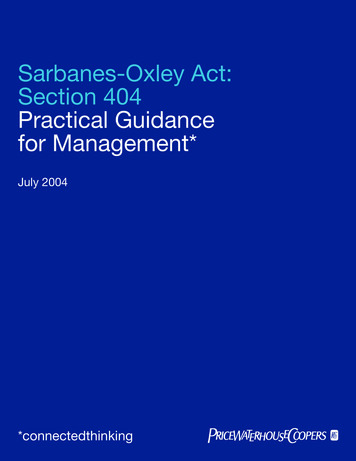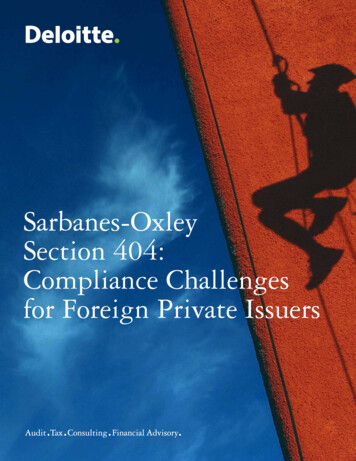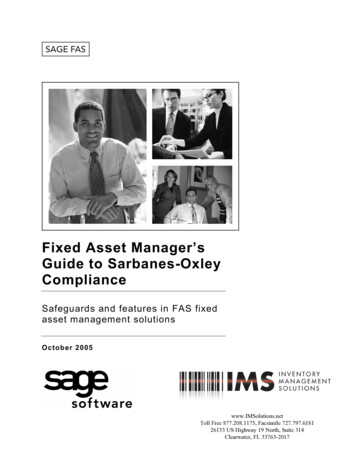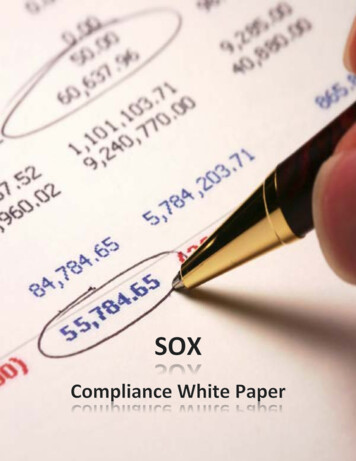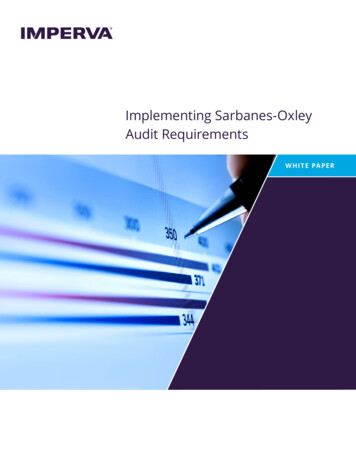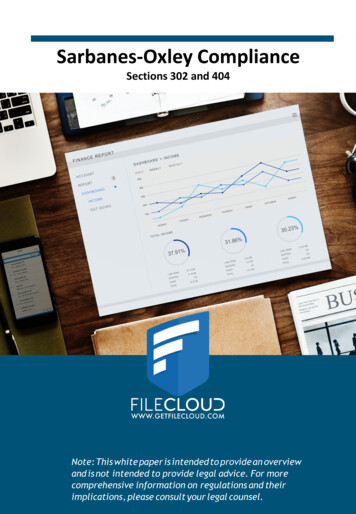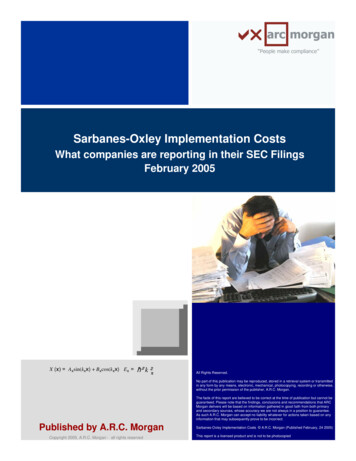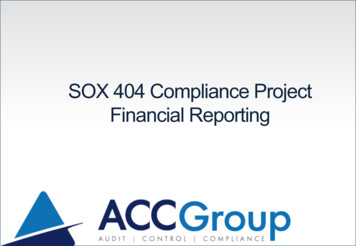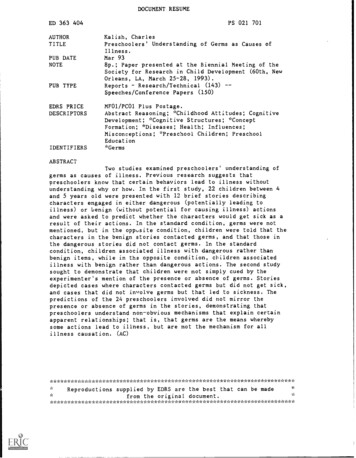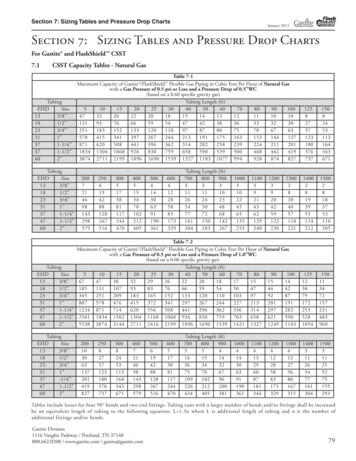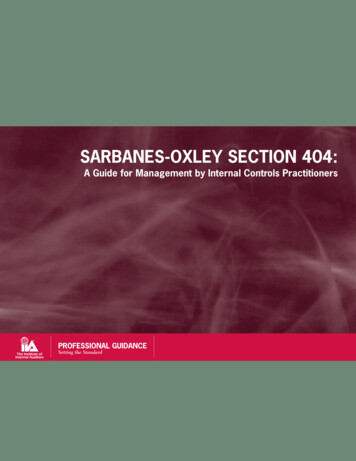
Transcription
SARBANES-OXLEY SECTION 404:A Guide for Management by Internal Controls Practitioners
SARBANES-OXLEY SECTION 404:A Guide for Managementby Internal Controls PractitionersThe Institute of Internal Auditors2nd Edition, January 2008
Table of ContentsAbout the Second Edition.iiiHow to Use This Guide. ivIntroduction. 1Summary for the CEO and CFO. 3A. Section 404: Rules or Principles. 9B.Revisiting the Principles of Internal Control. 11The COSO Framework. 15C.What Constitutes an Effective System of Internal Control as it Relates to theRequirements of Section 404?. 18D. Who Is Responsible for Internal Controls?. 19E.What Is the Scope of Management’s Assessment of the System of Internal ControlOver Financial Reporting?. 21F.Defining the Detailed Scope for Section 404. 251)Using a Top-down and Risk-based Approach to Defining the Scope. 252)The Detailed Process for Defining the Scope. 273)Materiality. 284)Significant Accounts and Disclosures. 285)Financial Statement Assertions. 306)Significant Locations, Business Processes, and Major Classes of Transactions. 307)Key Control. 31a.Identifying Key Controls Within Business Processes. 32b.Identifying Key ITGCs. 35c.Other Entity-level Controls. 39d.Spreadsheets and Other End-user Computing Issues. 41e.Controls Performed by Third-party Organizations (SAS 70 Type II Reports). 448)Fraud Risk Assessment. 459)Process and Control Documentation. 46The Institute of Internal Auditors / www.theiia.orgi
Table of ContentsG. Testing Key Controls. 481)Testing Automated Controls. 512)Testing Indirect Entity-level Controls. 52H. Assessing the Adequacy of Controls, Including Assessing Deficiencies. 54I.Management’s Report on Internal Controls — the End Product. 59J.Closing Thoughts on Efficiency. 61Acknowledgments. 64Notes. 65iiThe Institute of Internal Auditors / www.theiia.org
About the Second EditionThis is an updated version of The Institute of Internal Auditor’s (IIA’s) Sarbanes-Oxley Section404: A Guide for Management by Internal Controls Practitioners, one of its most frequently downloaded products. Changes include: Updated references to Auditing Standard No. 5 (AS 5) and the U.S. Securities and ExchangeCommission’s (SEC’s) guidance for management on Section 404 of the U.S. Sarbanes-OxleyAct of 2002. The first edition was based on the top-down and risk-based approach adoptedin both documents, and the second edition updates the discussion and extends the guidanceprovided by the regulators. An expanded and updated discussion of information technology (IT) general controls scopingbased on The Institute’s Guide to the Assessment IT General Controls Scope Based on Risk(GAIT) products. An extended discussion of the role of entity-level controls. The benefit of additional years of experience with management’s assessment of internalcontrol over financial reporting (ICFR).The approach discussed in this guide has proven successful over the last few years, streamliningmanagement’s processes, and effecting major reductions in total assessment cost.The Institute of Internal Auditors / www.theiia.orgiii
How to Use This GuideOrganizations can use this guide to ensure their program for assessing the system of internalcontrol over financial reporting is not only effective but also cost-effective. They will use this guideto: Supplement and extend the guidance for management that has been provided by the SEC. Assess the efficiency of their Section 404 program, such as how to minimize total assessmentcosts, including related external auditor fees. Revisit their assessment process and compare it to best practices identified by experiencedinternal control practitioners. Reconsider their processes for assessing deficiencies and providing an overall opinion.Management should provide an opinion that is based on principles instead of rules (i.e., anopinion that provides the investor with a fair assessment of the system of internal control). Itshould reflect the true condition of the internal control system, not one based on technicalities that could mislead the investor who needs to have confidence in the financial reports.Based on their role in their organization and responsibilities for Section 404, readers may use theguide in its entirety or read specific sections based on interest.The first and last sections — the “Summary for the CEO and CFO” and “Closing Thoughts onEfficiency” — merit all readers’ consideration.ivThe Institute of Internal Auditors / www.theiia.org
IntroductionVarious organizations have provided guidance on the subject of Section 404 and management’sannual assessment of its system of ICFR. The U.S. Public Company Accounting Oversight Board (PCAOB) provided an updated standard for external auditors in May 2007: AS 5, An Audit of Internal Control Over FinancialReporting That Is Integrated With an Audit of Financial Statements. Management actions are governed by the SEC and not the PCAOB. While the SEC endorsedAS 5, it also provided its own Commission Guidance Regarding Management’s Report onInternal Control Over Financial Reporting Under Section 13(a) or 15(d) of the SecuritiesExchange Act of 1934 in June 2007. This high-level guidance is not mandatory for management, but following it provides a safe harbor. Each of the major certified public accounting (CPA) firms and other providers of auditservices have published extensive and valuable guidance, generally consistent with PCAOBand SEC guidance.As noted above, following the SEC’s guidance provides management with a safe harbor. However,the guidance is at a high level and management may find additional, more detailed assistance isrequired. This document provides that additional level of assistance.The guide includes frequent references not only to SEC guidance but also to PCAOB guidanceas the greater level of detail in the latter is often helpful. In addition, as discussed later, it may beeasier to obtain a higher level of external auditor reliance on management’s testing if management’s and the auditor’s approaches are aligned.Internal auditors specialize in the assessment of internal controls and have for decades. They do soas a service to their organization’s audit committee and senior management team, and, therefore,have extensive insight into the operation of those controls and the constraints on managementin providing those controls. They are experts in the theory and practice of internal controls andrelated auditing.This guide — which is produced by The IIA, the recognized authority and standard-maker forinternal auditing in the United States and around the world — is written for management byexperienced internal auditors who have worked on internal controls hand-in-hand with the boardand management.The guide incorporates and reflects up-to-date guidance from the SEC, the PCAOB, The IIA, andthe real-world experience and insight of practicing internal auditors.Because cost is an issue for all management teams, this guide focuses especially on how totalassessment costs, including related external audit fees, can be minimized without impairing theeffectiveness of the program.The Institute of Internal Auditors / www.theiia.org1
INTRODUCTIONThe guide also discusses the interplay between the requirements of Section 404 and those ofSection 302. The latter requires annual and quarterly certifications by the chief executive officer(CEO) and chief financial officer (CFO)i that include assessments of internal controls.We encourage readers to review their Section 404 program with the head of their internal auditfunction, especially how the program ensures efficiency and minimizes disruption to the business.The internal auditor is uniquely positioned not only to review and test the key controls but alsoto provide internal consulting on the adequacy of their design and on the entire managementassessment and testing process. To this end, this guide contains a checklist that may be of value inassessing the efficiency of the program.2The Institute of Internal Auditors / www.theiia.org
Summary for the CEO and CFOWhen the U.S. Congress passed the Sarbanes-Oxley Act, the intent was to drive improvements incompanies’ internal controls. The benefits were seen as greater assurance to shareholders and otherstakeholders in published financial reports, while compliance costs were of lesser significance andwere dramatically underestimated.However, cost is of tremendous importance to corporate executives. While they have an obligationto provide an effective system of internal control that provides assurance regarding the integrityof financial reporting and the safeguarding of assets, there should be a balance between the costof those controls and the risks they are managing.Managers who are responsible for their company’s Section 404 program can obtain the followingbenefits from this guide, which is focused on achieving success at the lowest possible total cost,including external auditor fees: A clear understanding of the requirements of the Sarbanes-Oxley Act and the fundamentalsof internal controls. A discussion of how the annual requirements of Section 404 relate to the quarterly requirements of Section 302 (i.e., the quarterly certification by the CEO and CFO). An explanation and practical suggestions for each phase of the program, including areas ofdifficulty: the identification of key controls, assessing deficiencies, and the final assessment. Advice on how to reach a fair assessment that does not mislead investors regarding the condition of internal controls and the reliability of financial statements. We believe management’sformal assessment should reflect their belief as to whether the system of internal controlprovides reasonable assurance of the reliability of future1 financial statements.ii That reliability is based on the likelihood of an error that would be material to a reasonable investor.An assessment that the controls are not effective simply because there has been a restatementof previously issued financial statements may mislead the investor regarding the current stateof internal controls and the reliability of future financial statements.1 The guidance published by the SEC and PCAOB does not address this issue directly. However, there are indicationsin comments by officials with these organizations that the value of the Section 404 assessment is that it provides alevel of comfort with respect to the reliability of future financial statements assuming there is no significant change inthe quality of the system of internal control. The quality of the system of internal control at the end of the reportingyear is an indication of whether it is sufficiently robust to either prevent or detect material misstatements in financialstatements that will be prepared under the processes and related controls that management has assessed. In addition,an assessment of the likelihood of any event is difficult, if not impossible, without defining the period during whichthe event may occur. In this guide, we have taken the reasonable position that management’s assessment should reflectthe likelihood of a material misstatement in one or more of the next 12 months’ financial statement filings. Neither theSEC nor the PCAOB have publicly commented on this matter, and our position relative to 12 months — which wouldinclude the next ann
A checklist to help management assess the efficiency of their program. Some companies have adopted a methodology for Section 404 that is rules-based.iii This can lead to an assessment that is neither effective nor efficient. Instead, management should use judgment to develop and operate a continuing Section 404 program that is principles-based.File Size: 579KBPage Count: 78
